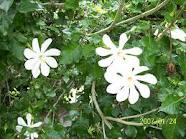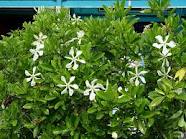Gardenia
|
These are tender shrubs from China, Japan, tropical and South Africa. They grow into bushes or small trees. They have ovate, glossy, dark green leaves and large, white, waxy, fragrant flowers that can be single or double. Gardenias are rarely successful when grown as houseplants. Lack of humidity is a big part of that, but other reasons may include drafts, fluctuating temperatures, insufficient sunlight, and keeping the required acidity of the soil. The hothouse plant, Gardenia jasminoides (Veitchii), requires a minimum temperature of 60 degrees. It is mainly winter flowering and is often sold in bloom at Easter. Gardenia jasminoides Fortuniana is often more successful. It blooms during the summer and may be grown in the North in large pots or tubs, which are set outdoors in summer and brought into a frost-free, cool, light cellar or similar place in the winter.
Pot CultivationThe best compost to use consists of equal parts of peat, loam and well-decayed manure, with a good amount of sand and a bit of crushed charcoal added. Repotting should be done in February. Shorten the long shoots and spray them frequently to induce new shoots to form. Then a little of the old soil is removed and they are placed in larger pots. When they are established, they need to be set in direct sunlight and the atmosphere must be constantly humid. The leaves need to be sprayed with water quite often. Water is given often in the summer and a liquid fertilizer is applied on a weekly basis to established plants. Less water is given in the winter, but neither the soil nor the atmosphere should be dry for too long. If the flower buds are removed during the summer, the plants will bloom in the fall and winter. PropagationIn March, cuttings of young shoots, 3 inches long, can be inserted in sandy peat and placed in a propagating case with bottom heat. They must be kept moist until roots are formed. They are then potted in 3-inch pots using a compost of equal parts of loam, peat and leaf mold with a good amount of coarse sand added. They are then returned to the propagating case until they're established. They are then potted in 5-inch pots, set in a shady area and frequently sprayed with water. When the pots have filled with roots, they are repotted in 7-inch pots where they will flower the next year. Pinching off the tips of the shoots encourages bushiness. These plants can also be increased by air layering.
Varieties
|






